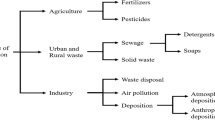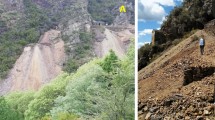Abstract
In Nigeria, almost all industries produce waste, which is typically disposed of with often little consideration given to environmentally friendly procedures. This study assessed the potential impact of pollution by slaughterhouse wastes on specific soil particle distribution, texture, physicochemical properties, and heavy metal concentrations in Ebonyi State, Nigeria. Samples of soil were taken at depths of 0–20 cm, and were examined using standard laboratory techniques. The results obtained from the determination of soil particle size distribution and textures were found to indicate a categorization of sandy loam in all the locations studied. The results indicate that slaughterhouse wastes decreased soil bulk density while increasing soil total porosity and gravimetric moisture contents in all the slaughterhouse soils compared to soils of the control locality. The mean soil pH values around the slaughterhouse (5.70–5.78, 5.13–5.25, and 5.47–5.59) were observed to be lower than the mean pH values (6.08–6.09) of soils of the control site, which indicated that the slaughterhouse soils are acidic in nature. Soils located around the slaughterhouse had higher exchangeable sodium (Na) and the lowest levels of exchangeable calcium (Ca) than soils of the control areas. The highest amounts of heavy metal contents were recorded in soils around the slaughterhouses, indicating that the presence of slaughterhouse wastes correlated with the soil's accumulation of heavy metals. Based on the foregoing results, it is submitted that slaughterhouse wastes should be treated using anaerobic digestion before being released into the environment, since they have a significant potential for pollution.

Source: Department of Geography, Alex Ekwueme Federal University Ndufu Alike, Ebonyi State, Nigeria

Source: Department of Geography, Alex Ekwueme Federal University NdufuAike, Ebonyi State, Nigeria

Source: Researcher’s Intern, 2022
Similar content being viewed by others
Data availability
The data sets generated during this work are not publically available for reasons known to the authors, but they are available upon reasonable request from the corresponding author.
References
Adelegan JA (2020) Environmental policy and slaughterhouse waste in Nigeria. In: Proceedings of the 28th WEDC conference Kolkata (Calcutta) India, pp 3–6
Adriano DC (2022) Trace elements in terrestrial environments: biochemistry, bioavailability and risk of metals, 2nd edn. Springer, New York, USA, p 288
Allen SE, Grinshaw HW, Pancinson JA, Quarmby L (2014) Chemical methods of analyzing ecological materials. Blackwell Scientific Publications, Oxford, London, UK, p 505
Alu MO, Njoku C, Okafor OC, Nwite JN (2018) Effect of abattoir wastes on selected soil properties in Ebonyi State Southeastern Nigeria. Indian J Ecol 45(4):850–853. https://doi.org/10.4314/naj.v49i1
Bates RG (2018) Electrometric pH determinations. John Wiley and Sons Inc., New York, USA, p 29
Bray RH, Kurtz LF (2018) Determination of total organic and available forms of phosphorus in soils. Soil Sci 59:39–45
Bremmer JN, Mulvaney CS (2015) Total Nitrogen in method of soil analysis part 2. Agronomy. American Society of Agronomy, Madison, WI, pp 599–622
Chibuike GU, Obiora SC (2022) Heavy metal polluted soils: effect on plants and bioremediation methods. Appl Environ Soil Sci 2014:752708
Chukwu UJ, Anuchi SO (2022) Impact of abattoir wastes on the physicochemical properties of soils within port Harcourt metropolis. Int J Eng Sci (IJES) 5(6):17–21
Chup CD (2017) Population dynamics and sustainable environmental resource management in the federal capital territory: the agro forestry option. Niger Geogr J 5(1):29–34
Coker AO, Olugasa BO, Adeyemi AO (2022) Abattoir and wastewater quality in South Western Nigeria: In: Proceedings of the 27th water engineering and development center conference, Lusaka, Zambia, pp 23–30
David NO, Benjamin LK, Patrick OY (2017) Some physiochemical and heavy metal levels in soils of waste dumpsites in Port Harcourt municipality and environs. J Appl Sci Environ Manage 13(4):65–70. https://doi.org/10.4314/jasem.v13i4.55414
Ebong GA, Ekomobong SE, Emmanuel UD (2017) Impact of Abattoir wastes on trace metal accumulation, speciation, and human health-related problems in soils within Southern Nigeria. Air Soil Water Res 13:1–14. https://doi.org/10.1177/1178622119898430
Egboka BCE, Okpoko EI (2014) Gully erosion in the Agulu-Nanka region of Anambra State, Nigeria. J Challenges Afr Hydrol Water Resour 7(144):330–340
Ezeoha SL, Ugwuishiwu BO (2019) Status of abattoir wastes research in Nigeria. J Environ Technol 30(2):1–6. https://doi.org/10.4314/NJT.V30I2
Fadeyibi A, Halilu A, Osunde ZD (2018) Analysis of physicochemical properties of abattoir wastewater for irrigation in Minna, Niger State. J Water Air Soil Pollut 2(2):12–15
Ibitoye AA (2006) Laboratory Manual on Basic Soil Analysis. Foladave Nigeria Ltd., Nigeria, pp 16–36
Kamper AP, Rosenau RC (2017) Size distribution of aggregate in methods of soil analysis. In: Klute A (ed) Method of soil analysis. Part 1. Agronomy monograph, 2nd edn. GASA-SSSA, Madison, WI, pp 425–442
Nafarnda WD, Yaji A, Kubkomawa HI (2022) Impact of abattoir waste water on aquatic life: a case study of Yola abattoir. Glob J Pure Appl Sci 12(1):31–33. https://doi.org/10.4314/gjpas.v12i1.16540
Neboh GA, Henry JI, King AA (2022) Effect of Abattoir effluent on the physical and chemical properties of soils. Environ Monit Assess 16(8):444–458. https://doi.org/10.1007/s10661-009-1058-7
Norton LDS, Hainberg L, Gweck JR, Edwards DA, James H (2022) Erosion and soil chemical properties. MSc thesis. University of Agriculture, Uganda, pp 15–17
Obi IU (2016) Statistical methods of detecting difference between treatment means and research methodology issues in laboratory and field experiments, 2nd edn. Ap Express Publishers Limited, Nsukka, Nigeria
Ojekunle OZ, Lateef ST (2022) Environmental impact of abattoir waste discharge on the quality of surface water and ground water in Abeokuta. J Environ Anal Toxicol 7(5):9–22. https://doi.org/10.4172/21610525.1000509
Okafor OC, Obaze WO, Njoku C, Udenze SC (2023) Effect of waste disposal sites on physicochemical properties of water in selected states of Southeast Nigeria. J Environ Monitor Assess 195:701. https://doi.org/10.1007/s10661-023-11311-9
Okoronkwo NE, Odemelan SA, Ano OA (2021) Levels of toxic elements in soils of abandoned waste dump in cities. Afr J Biotechnol 5(13):1241–1244
Omole DO, Longe EO (2018) An assessment of the impact of abattoir effluents on river Illo, Ota, Nigeria. J Environ Sci Technol 1(2):56–64. https://doi.org/10.3923/jest.2018.56.64
Osu CI, Okereke VC (2020) Heavy metal accumulation from abattoir wastes on soils and some edible vegetables in selected areas in Umuahia metropolis. Int J Curr Microbiol Appl Sci 4(6):1127–1132
Rabah AB, Oyeleke SB, Manga LG, Hassan UJ, Ijah KU (2022) Microbiological and physicochemical assessment of soil contaminated with abattoir effluents in Sokoto metropolis, Nigeria. Sci World J 5(3):1–4
Walkley A, Black CA (1934) An examination of the Degtjareff method for determining soil organic matter, and a proposed modification of the chromic acid titration method. Soil Sci 37:29. https://doi.org/10.1097/00010694-193401000-00003
Wawer M, Magiera T, Ojha G, Appel E, Kusza G, Hu S, Basavaiah N (2020) Traffic-related pollutants in roadside soils of different countries in Europe and Asia. Water Air Soil Pollut 22:6–25. https://doi.org/10.1007/s11270-015-2483-6
Zaku SG (2021) Quality assessment of soil in Donga, Ibi and Wukari local government areas in Taraba State. M.Tech Dissertation. Federal University of Technology, Yola
Acknowledgements
Our profound appreciation goes to the almighty God for his protection, goodness and mercy throughout the period of the study. We also express our gratitude to the staff of Department of Geography, Alex Ekwueme Federal University Ndufu Alike, Ebonyi State, Nigeria and Department of Soil Science and Environmental Management, Ebonyi State University, Nigeria who made their laboratory facilities available for the analysis of this research.
Funding
There is no fund, grant, or other support received during the preparation of this manuscript.
Author information
Authors and Affiliations
Contributions
All authors contributed to the study conception and design. Material preparation, data collection and analysis were performed by OCO, MN, CN and PIO.
Corresponding author
Ethics declarations
Conflict of interest
On behalf of all authors, the corresponding author states that there is no conflict of interest.
Ethical approval
It does not require ethical approval. The article has not been previously submitted for publication in any publisher. I also has not been published anywhere.
Additional information
Publisher's Note
Springer Nature remains neutral with regard to jurisdictional claims in published maps and institutional affiliations.
Rights and permissions
Springer Nature or its licensor (e.g. a society or other partner) holds exclusive rights to this article under a publishing agreement with the author(s) or other rightsholder(s); author self-archiving of the accepted manuscript version of this article is solely governed by the terms of such publishing agreement and applicable law.
About this article
Cite this article
Okafor, O.C., Nwojiji, M., Njoku, C. et al. Assessment of pollution potentials of slaughterhouse wastes on physicochemical properties of soil in Ebonyi State Nigeria. Environ Earth Sci 83, 47 (2024). https://doi.org/10.1007/s12665-023-11380-6
Received:
Accepted:
Published:
DOI: https://doi.org/10.1007/s12665-023-11380-6




